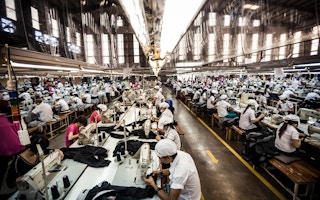London’s Oxford Street, New York’s 5th Avenue, Paris’s Champs Elysées, Singapore’s Orchard Road: These iconic destinations are famed for hawking the fashion industry’s latest offerings, but these glitzy retail experiences conceal a deeply unglamorous truth: The fashion industry is a hugely resource-hungry and wasteful one, churning out the equivalent of a garbage truck full of textile waste every second.
The US$1.3 trillion clothing industry, which sustains 300 million jobs from production to retail, takes in about 98 million tonnes of oil, fertiliser, chemicals and dye, and 93 billion cubic metres of water annually.
Experts have cautioned that maintaining status quo has “potentially catastrophic” environmental, and economic consequences, and this warning has been amplified by high-profile activist campaigns calling on fashion to clean up its act.
Some companies have responded with solutions such as apparel made from recycled waste; clothing takeback programmes; and textile recycling innovations. Many are working towards the goal of a circular economy, where clothes and raw materials are used more efficiently, and waste is eliminated.
But while individual innovations are valuable, systems-wide change remains an unfulfilled goal, say observers.
As Kia Jiehui, principal strategist at international sustainability non-profit Forum for the Future says: “There is a gap between the buzz of niche innovations and large-scale solutions that disrupt entrenched wasteful practices in value chains.”
Large manufacturers in brands’ supply chains hold the key to bridging this gap because they are already producing at quality, speed, and volume, she says. “They will therefore be the ones to deliver circular solutions at scale.”
“Apparel brands which are serious about making the fashion industry circular will only be successful if their suppliers see the value of adopting circular practices as well,” adds Kia.
With China, India, Bangladesh and Vietnam among the world’s largest garment exporters, Asia is undoubtedly the beating heart of fashion supply chains, and home to many of the companies which are a crucial part of the effort to make fashion circular.
One such player is Yee Chain International, which is based in Taiwan and has a regional network of factories which make the stretchy, colourful fabrics used in sneakers.
The company’s sustainability officer Martin Su, tells Eco-Business: “We make the equivalent of 48 million pairs of shoes a year. But about 2 million pairs a year are wasted, and that’s a conservative estimate.”
Why does fashion manufacturing have such a huge waste problem, and what are the key obstacles to addressing this? As manufacturers, brands, and sustainability experts see it, the industry’s complex structure, far-flung supply chains, and relentless pace give rise to four key problems:
1. Laborious logistics
The fact that clothes are often made, and sold, in completely different and disconnected locations poses a major challenge, says Kia.
“If a product was designed, sampled, mass produced, and sold in a single country, you would have a proper network of physical infrastructure to take back and recycle clothing,” she explains.
“But because the forward supply chain has become so global, the reverse supply chain—that is, getting products back from consumers—is much harder,” she says.
In a few years, manufacturers could turn their attention from markets half a world away to those closer to home as consumption in emerging markets—most noticeably Asia—grows. This could facilitate localised reverse logistics infrastructure, says Kia.
2. Power problems
Another obstacle is the unequal power dynamic between manufacturers and their clientele; manufacturers sandwiched between huge raw materials conglomerates and global brands find it hard to say no to customer demands, wasteful as they may be.
Yee Chain’s Su shares that reasons for this wasteful practice can range from capricious designers who have little regard for the supply chain implications of requesting multiple samples to anxiety about meeting increasingly specific consumer tastes.
“At the end of the day, [brands] are the ones who pay the bills and we have to listen to them,” says Su.
Su notes that usually, manufacturers also don’t get access to the right decision makers within their buyer’s company who could help them break these entrenched patterns.
“Suppliers usually work with materials and sourcing teams, and for them, price trumps everything else,” he says. “But maybe the corporate social responsibility or marketing departments would see things differently.”
3. Mismatched motives
The breakneck pace of fast fashion also sets up perverse incentives that ignore, or even condone wastage, says Forum’s Kia.
Brands demand that their suppliers deliver on “crazy tight” timelines, and even fine manufacturers for faulty products, says Kia. These dual pressures lead suppliers to resort to overproduction as a way to compensate for manufacturing faults.
Kia observes: “Generating lots of waste is overall less costly than losing business.”
Charging for waste production—as is done in Taiwan—or even a carbon tax, could fix this skewed incentive, suggests Kia.
Yee Chain’s Su notes that manufacturers also stock up to quickly fulfil orders according to what brands forecast, which can be weeks or months before an actual order is placed. “But if the order ends up being smaller, it leads to a lot of wastage.”
4. Tech trials
Some brands are bucking the trend of this problematic power dynamic.
Swedish fashion giant H&M, for instance, plans to be “100 per cent circular and renewable”, using only recycled or sustainably sourced materials by 2030, and was among the first in the industry to introduce in-store clothing takeback.
Global environment manager for production Harsha Vardhan says H&M invests heavily in technologies like digital sampling and sourcing expertise to minimise over-ordering and over-sampling problems.
H&M realises there are challenges with quality and prices and it is willing to absorb the higher costs in the short-term in order to support suppliers as they switch to circular practices, Vardhan notes.
But even for these brands, some technological challenges remain. For instance, there is just no recycling solution available for materials like acrylic, while clothes made from mixed fibres also pose a costly recycling challenge, says Vardhan.
Other materials are more expensive in their recycled form compared to virgin fibres says Vardhan, adding that more innovation is required to tackle these challenges.
Making it better
As manufacturers and brands alike acknowledge the scale of fashion’s waste challenge and pursue solutions to make the industry more circular, Forum for the Future has developed the Circular Leap Asia (CLA) initiative to accelerate progress.
The programme brings manufacturers and brands together on a common platform to identify barriers to a circular economy, and pilot-test solutions.
With Forum for the Future acting as a “neutral facilitator”, Kia notes that CLA promotes a more collaborative environment than the standard client-and-vendor dynamic.
For Yee Chain’s Su, a programme like CLA could help manufacturers overcome several challenges.
“A platform for manufacturers and retailers to engage in open dialogue would connect me with the people I need to speak with but don’t have access to, and give me a different position to speak to them from,” he says.
Ultimately, big fashion knows it has to change, and it’s not going to see meaningful results if the suppliers that are the bedrock of the industry can’t have their voices heard or concerns addressed, Kia says.
As H&M’s Vardhan puts it: “As a brand, we cannot set up goals and hope that suppliers will achieve it. We have to enable them through investment and innovation,” he says. “The whole industry has to work together to solve sustainability challenges.”














